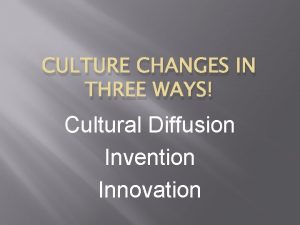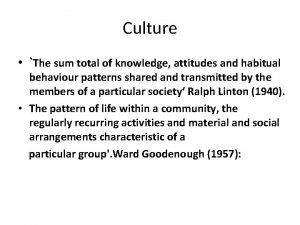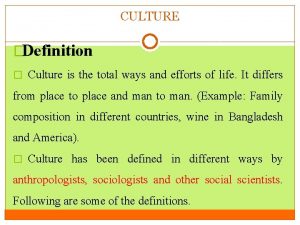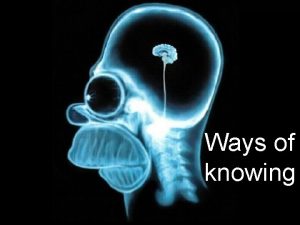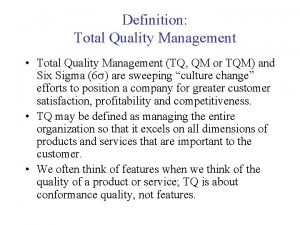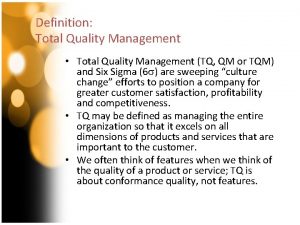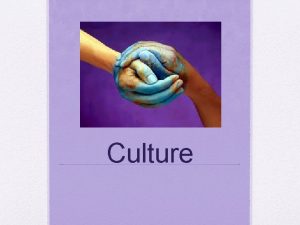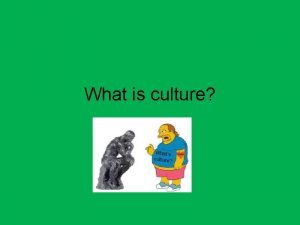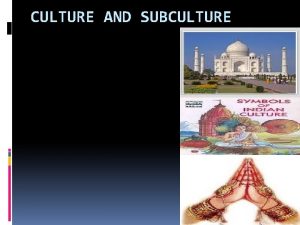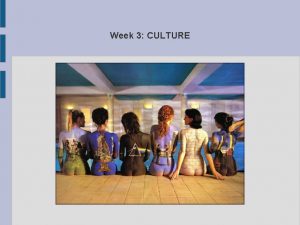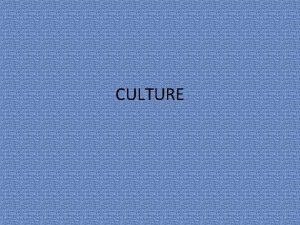CULTURE Definition Culture is the total ways and























- Slides: 23

CULTURE �Definition � Culture is the total ways and efforts of life. It differs from place to place and man to man. (Example: Family composition in different countries, wine in Bangladesh and America). � Culture has been defined in different ways by anthropologists, sociologists and other social scientists. Following are some of the definitions.

� 1. Culture is that complex whole which includes knowledge; belief, moral, attitude, law, custom and any other capabilities and habits acquired by man as a member of society. - E. B. Tylor � 2. � 3. Mac Iver told “Culture is what we are or have”. Cooley, Angel & Carr “Culture is the sum total of transmittable result of living together.

� 4. Jones” Culture is the sum of man’s creation”. � 5. Roberty says, “Culture is that body of thought and knowledge ( including both theoretical and practical), which only man can possess. � 6. Malanowski defined culture as the handiwork of man and the medium through which he achieves his end.

Characteristics of Culture � 1. Culture is Learnt � 2. Culture is Social � 3. Culture is Shared � 4. Culture is Transmissive � 5. Culture is Continuous and Cumulative � 6. Culture is Consistence and Integrated � 7. Culture is Dynamic and Adaptive � 8. Culture is Gratifying � 9. Culture varies from Society to Society � 10. Culture is superorganic and ideational

Classification of Culture �Culture is of two types:

Differences between MC and NMC � 1. Material Culture is (MC) directly related in our life. Non Material Culture (NMC) only can influence our life. eg. Social art, literature and music � 2. MC is visible and transferable. NMC is not visible. It is inward state of human mind. � 3. Economics development is directly related with MC. Economic development is not directly related with NMC.

� 4. Change of MC can be seen externally but change of NMC occurs mentally. � 5. Ogburn says that MC changes fast. and NMC cannot change so fast. � 6. MC is the result of NMC (Thought and sprit). NMC is the source of MC.

Differences between Culture and Civilization � Gigsbert says that civilization is supposed to be a stage of culture reached by a more evolved and complex society in which those large aggregations of peoples, called cities, come into existence. The Differences between Culture and Civilization are as follows:

� 1. Mac. Iver says culture is what we are and civilization is what we use. � 2. Culture is the corporate personality and civilization is the achievement of that personality. � 3. Culture is not universal and civilization is universal. � 4. Culture is not perishable but civilization is perishable. eg. Babilion people. � 5. Culture is the inward state of man. Civilization is the outward bahaviour.

� 6. Culture develops in rural area and civilization develops in urban area. � 7. Culture cannot be measured but civilization can be measured. eg. Motor is faster than Horse, Aeroplane is faster than Motor. These can be measured because it is the result of science and technology. But drama, literature and art cannot be measured so easily. � 8. Cultural value, religious philosophy, political philosophy is not easily accepted and adopted by others. But the result of civilization can be accepted easily by others.

� 9. Cultural works cannot be done by others for one. In case of civilization one can do in favour of other. eg. One can build a building for another. But one cannot sing a song in favour of others. � 10. Mac. Iver and Page say civilization is always advancing but not culture. They again say that civilization is passed on without effort, but not culture. They further say that civilization is borrowed without change or loss but not culture. Culture shows the way sitting idle with the steering of a running vessel (ship) called civilization. � 11. Culture is static and civilization is dynamic. � 12. Culture is stock concept and civilization is flow concept.

Elements of Culture � There are some elements of culture. Element means a part of a longer whole. Following are the elements of culture: � 1. Trait 2. Complex 3. Pattern � 4. Theme 5. Configuration 6. Ethos

� Traits : Traits are the smallest unit of culture and we cannot divide it. Non material traits are attitude, sentiment, belief etc. and material traits are chair, table, ball etc. Trait has also some parts�a) form b) use c) meaning d) function and

� Complex : Complex is a combination of related traits. Ball, bat and gloves are parts a sports complex. Kiss, handshake and sharing verbal intimacies are parts of love complex. Books, papers, lectures and classroom are part of education complex.

� Pattern : A pattern is a group of culture complexes formed in the same way of culture complex. For example, culture pattern of rural Muslim is different from pattern of urban Muslim society. � Theme : Every culture has its own theme. Muslim culture has a different theme than Hindu culture.

� Configuration: We can see and understand the whole society by the cultural configuration. All the activities and elements of the culture of society are kept under consideration while assessing a culture. � Ethos : Ethos is the judgment or flavour of society. We can understand compare which is upper class society and which is lower class by the ethos.

These are also known as organizational structure of culture. There are some other important elements of culture. � Symbol 1. The : existence culture of dependent is on peoples’ ability to create and understand symbol. A symbol is something used to represent else. Words, number, flags, crosses and kisses are symbols. During 2 nd world war, raising the middle and index finger of one hand was the symbol ‘V’ for victory. During 1960 s the same gesture came to symbolize ‘peace’. � Stop sign means halt, Cross is a symbol of Christianity etc.

� 2. Language The : mostimportantsetsymbol is language. Language, among human, refers to the systematized usage of speech and hearing to convey or express felling and ideas. Our ideas, values, belief and knowledge are transmitted through language. � (Example: Experiment with same aged infant and Chimpanzee by psychologists 19 1951)

� 3. judge about what is desirable, beautiful, correct and good as well as what is undesirable, ugly, incorrect and bad. Values may also be defined as the measures of goodness or desirability. � Most values are learnt early in life from family, friends, mass media and other sources of society. These become part of our personality.

4. Social Norms: All societies have acceptable and unacceptable forms of behaviour, which are called Norms. In other words norms are social expectation for behaviour. They are � a. Prescriptive (they tell people what they should do) and � b. Prospective (they tell people what they should not do) � For example Honesty is a general value. The expectation that the students should not cheat on quiz test is a norm. Norms are of two types: a. Folkways b. Mores. These two are differentiated not by their content but by the degree of importance.

�a. Folkways : Folkways are customs or conventions. Folkways are expected form of behaviour but are not rigidly enforced in society. Violations of folkways bring criticism or mild censure but not punishment. Example: Giving Salam to elders, eating by right hand are folkways.

� b. considered essential by the society. They are rigidly enforced. Violation of norms may bring severe penalty from society. The punishment may involve expulsion from society, imprisonment or even death. Example: A doctor must treat an old patient of terminal illness. He should not end his life because of cultural mores. � There is another element of culture called Taboos.

� Taboos : Certain acts, which are to be avoided at all costs, are called taboos. To love and care for one’s children or sister is mores but incest them or neglect them are taboo, which is more or less universal.
 Romans 3:10
Romans 3:10 3 ways culture changes
3 ways culture changes Formula de roe
Formula de roe Total revenues minus total costs equals
Total revenues minus total costs equals Total revenues minus total costs equals
Total revenues minus total costs equals Total revenues minus total costs equals
Total revenues minus total costs equals Total revenue minus total expenses
Total revenue minus total expenses Total safety leadership
Total safety leadership The sum of the cultural
The sum of the cultural Material culture and nonmaterial culture
Material culture and nonmaterial culture Batch culture vs continuous culture
Batch culture vs continuous culture Difference between american and indian culture
Difference between american and indian culture Stab and stroke culture
Stab and stroke culture Folk culture and popular culture venn diagram
Folk culture and popular culture venn diagram Folk culture and popular culture venn diagram
Folk culture and popular culture venn diagram Anaerobic medium
Anaerobic medium Folk culture and popular culture venn diagram
Folk culture and popular culture venn diagram Anaerobic gaspak
Anaerobic gaspak Carpet culture microbiology
Carpet culture microbiology Surface culture deep culture and esol
Surface culture deep culture and esol Hát kết hợp bộ gõ cơ thể
Hát kết hợp bộ gõ cơ thể Lp html
Lp html Bổ thể
Bổ thể Tỉ lệ cơ thể trẻ em
Tỉ lệ cơ thể trẻ em

